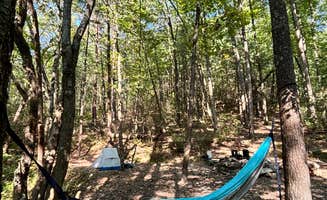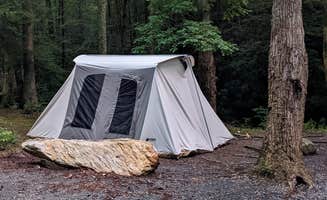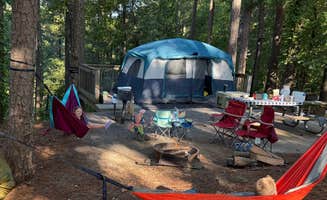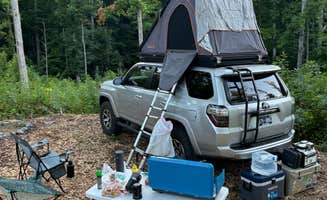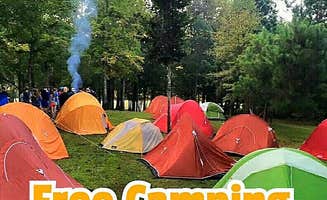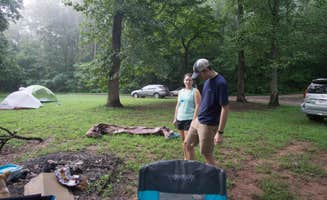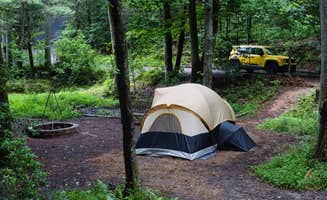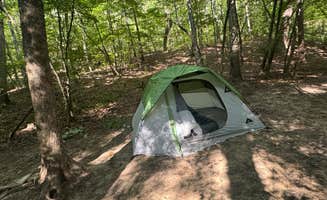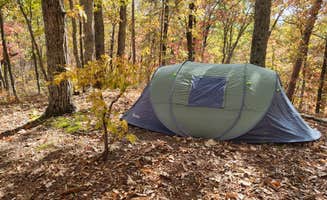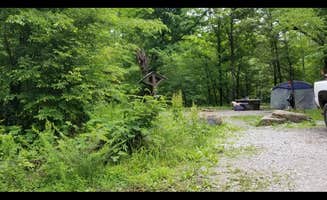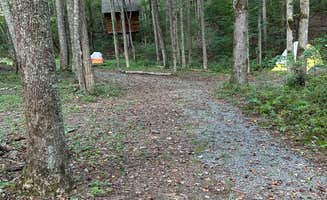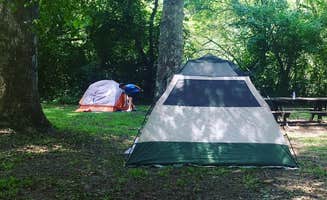Tent camping near Eton, Georgia places visitors within the Cohutta Mountains, part of the southern Appalachian range where elevations range from 700 to 4,200 feet. The region contains Georgia's largest wilderness area spanning over 36,000 acres of protected forest. Summer temperatures typically reach 85-90°F with frequent afternoon thunderstorms, while spring and fall offer cooler camping conditions with daytime highs between 60-75°F.
What to do
Creek swimming spots: At Hickey Gap Campground, the clear mountain streams provide natural cooling during hot summer months. One camper noted, "My girls group and I wanted to do a quick weekend glamping trip... Bring a bathing suit and some good hiking shoes." The creek offers multiple swimming areas with varying depths suitable for different ages.
Waterfall exploration: Several trails lead to waterfalls within 1-2 miles of campsites. A visitor to Long Creek Falls Appalachian Trail shared, "The falls are great for sitting and cooling off. The dispersed campsites are all along the creek so there is ample water all around." Trails to waterfalls generally range from easy to moderate difficulty.
Trout fishing: Three different trout streams converge at some camping areas, creating prime fishing conditions. According to one camper, "Three different trout streams come together here and the fishing is fun. There are rules about what kind of lures/hooks you can use, so be sure to do your research." Fishing licenses are required and can be purchased online or at local outfitters in Ellijay.
What campers like
Creek-side sleeping: The sound of flowing water creates natural white noise for better sleep. A visitor at Lost Creek Campground shared, "All you hear is the river at night. No cell service and its first come first served for a spot." Creekside sites tend to fill quickly, especially during summer weekends.
Backcountry solitude: Many sites offer true wilderness camping away from crowds. A hiker noted about Fort Mountain State Park Backcountry Campsites, "The site is private and pretty large. There were plenty of trees for hammocks and a few flat spots for small tents." Most backcountry sites require hiking between 1-5 miles to reach.
Wildlife viewing: The region supports diverse wildlife including deer, wild turkeys, and songbirds. One camper at Big Frog Area mentioned, "One of the most beautiful places I've ever been. Went up there when it was snowing and it was white and just absolutely gorgeous the views are spectacular." Early morning and dusk offer the best wildlife viewing opportunities.
What you should know
Vehicle requirements: Many forest roads require high-clearance vehicles, especially after rain. At Bear Creek Campground, "Once in the parking lot, you will need to shuffle your gear another 150-250 feet across a small wooden bridge to reach the dispersed camping sites." Plan your transportation accordingly.
Bear safety: Black bears inhabit the entire region. Hickey Gap Campground provides bear boxes, and a camper noted, "There was a pit toilet with plenty of toilet paper and it was quite clean. There's also a bear box and signs clearly indicating there are bears around and that you should keep all food in your vehicle or use the box." Food storage is mandatory at all sites.
Seasonal considerations: Weather can change rapidly in the mountains. Spring brings wildflowers but also unpredictable rain, while fall offers colorful foliage with cooler temperatures. Summer campers should prepare for afternoon thunderstorms and higher humidity levels, particularly in July and August.
Tips for camping with families
Beginner-friendly sites: Some campgrounds offer easier access for families with young children. A visitor to Woodring Branch Primitive Campground shared, "I love that this was a tent only camping site (no RVs). The sites were a bit smaller than I would have liked but as it was just the 10 sites on the road, the kids could safely play in the road."
Wildlife education: The forests around Eton provide opportunities to teach children about nature. A camper noted, "We saw tons of chipmunks around, they were definitely after our food both at our campsite and hiking. We also really enjoyed doing some bird watching and trying to figure out what birds were which."
Swimming safety: Creek waters can run cold and swift, especially after rain. One visitor advised, "There are spots that you can swim around in" but parents should always supervise children near water. The best swimming holes tend to be in wider sections of streams where water flows more slowly.
Tips from RVers
Size restrictions: Most primitive camping areas near Eton can only accommodate smaller rigs or trailers. At Hickey Gap, a camper warned, "The driveway to and from the camp area is quite steep. Our 2WD (front wheel drive) Honda Passport struggled to get back up it on our way out, and we had to hit the steepest part with some speed to make it out."
Parking limitations: Many areas have small parking lots that fill quickly. A review mentioned, "Nice but super crowded on the weekend" regarding Lost Creek Campground, where parking can be limited to 8-12 vehicles total.
Road conditions: Forest service roads deteriorate after heavy rain. According to a visitor, "Super remote area, ride were in decent shape, I could see them being bad after a heavy storm. Gravel 7 miles to here." Always check road conditions with the Forest Service before driving to remote tent camping sites near Eton with any type of RV.


